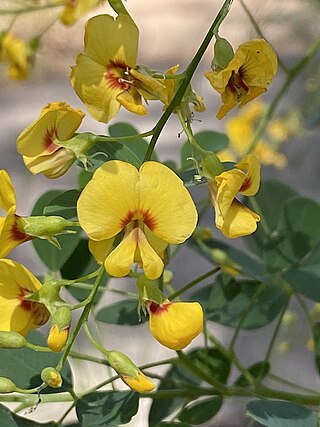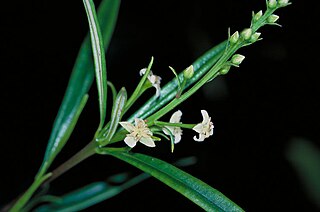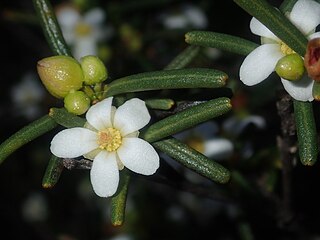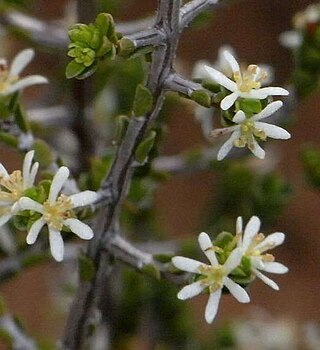
Micrantheum is a genus of four species of flowering plant in the family Picrodendraceae and is endemic to Australia. Plants in the genus Micrantheum are heath-like, monoecious shrubs with simple leaves usually in groups of three, and flowers arranged singly or in small clusters in leaf axils, male flowers with three, six or nine stamens.

Pimelea humilis, also known as common riceflower or dwarf riceflower, is a species of flowering plant in the family Thymelaeaceae and is endemic to south-eastern Australia. It is an erect or scrambling shrub with hairy stems, elliptic to lance-shaped leaves and heads of 12 to 52 of creamy-white, bisexual or female flowers.

Goodenia montana, commonly known as mountain velleia, is a flowering plant in the family Goodeniaceae. It is a small, perennial herb with lance-shaped to egg-shaped leaves with the narrower end towards the base, and yellow flowers. It mainly grows in woodland and sub-alpine grasslands in New South Wales, Victoria and Tasmania.

Micrantheum serpentinum, commonly known as western tridentbush, is a species of flowering plant in the family Picrodendraceae, and is endemic to north-western Tasmania. It is a straggly, monoecious shrub with oblong to narrowly egg-shaped leaves and yellowish to greenish flowers.

Goodia lotifolia, commonly known as golden tip or clover tree, is a species of flowering plant in the family Fabaceae and is endemic to eastern Australia. It is a sometimes tall shrub with trifoliate leaves, the leaflets narrowly egg-shaped with the narrower end towards the base, and bright yellow, pea-like flowers with red or brown markings.

Zieria arborescens, commonly known as the tree zieria or stinkwood, is a plant in the citrus family Rutaceae and is endemic to eastern Australia. It is a bushy shrub or small tree with branches that are ridged and scaly or hairy, at least when young. It has leaves composed of three leaflets and groups of flowers with four white petals, the groups usually shorter than the leaves.

Micrantheum ericoides is a species of flowering plant in the family Picrodendraceae and is endemic to eastern Australia. It is a small, heath-like, monoecious shrub with linear to narrowly elliptic leaves, and small white or pinkish flowers arranged singly or in pairs.

Hibbertia ericifolia is a species of flowering plant in the family Dilleniaceae and is endemic to south-eastern Australia. It is small, sometimes low-lying to spreading shrub with wiry stems, linear to narrow elliptic leaves, and yellow flowers arranged on the ends of branchlets, with ten to twenty-four stamens arranged around the three carpels.

Philotheca virgata, commonly known as Tasmanian wax-flower, is a species of flowering plant in the family Rutaceae and is endemic to south-eastern Australia. It is a slender, erect shrub with wedge-shaped to oblong leaves and white or pale pink flowers at the ends of branchlets. It is the only philotheca with four sepals and petals.

Ricinocarpos ledifolius is a species of flowering plant in the family Euphorbiaceae and is endemic to eastern Queensland. It is a monoecious or dioecious shrub or small tree with linear leaves and white flowers, arranged either singly, or with two or three female or two to six male flowers, or a single female flower surrounded by two male flowers.

Micrantheum demissum is a species of flowering plant in the family Picrodendraceae and is endemic to the south-east of South Australia. It is a dense, dwarf, monoecious shrub with lance-shaped to egg-shaped leaves arranged in whorls of three, and pink flowers, arranged in leaf axils in groups of up to three.

Pseudanthus ligulatus is a species of flowering plant in the family Picrodendraceae and is endemic to northern Queensland. It is a monoecious shrub with simple, lance-shaped or linear to narrowly oblong leaves and creamy white male and pale green female flowers arranged singly in upper leaf axils, but appearing clustered on the ends of branches.
Stachystemon mucronatus is a species of flowering plant in the family Picrodendraceae and is endemic to the south-west of Western Australia. It is a compact, monoecious shrub with narrowly oblong or narrowly elliptic leaves and small, greenish yellow flowers arranged singly in upper leaf axils.

Ricinocarpos psilocladus is a species of flowering plant in the family Euphorbiaceae and is endemic to the west coast of Western Australia. It is an erect, open, monoecious or dioecious shrub with linear to narrowly oblong or narrowly egg-shaped leaves, and white or yellow flowers arranged singly, or with two to five male flowers, or a single female flower surrounded by up to three male flowers.

Pseudanthus orientalis is a species of flowering plant in the family Picrodendraceae and is endemic to the coast of eastern Australia. It is a compact, rigid, monoecious shrub with simple, linear to narrowly oblong leaves and yellow to creamy-white flowers arranged singly in upper leaf axils, but often appearing clustered on the ends of branches.

Pseudanthus ovalifolius, commonly known as oval-leaf pseudanthus, is a species of flowering plant in the family Picrodendraceae and is endemic to south-eastern Australia. It is a spreading to compact, wiry, monoecious shrub with oval leaves and whitish flowers arranged singly in upper leaf axils, but sometimes appearing clustered on the ends of branches.
Pseudanthus pauciflorus is a species of flowering plant in the family Picrodendraceae and is endemic to eastern Australia. It is a compact, monoecious shrub with simple, lance-shaped or narrowly elliptic to narrowly oblong leaves and creamy white flowers arranged singly in upper leaf axils, but appearing clustered on the ends of branches.
Ricinocarpos speciosus is a species of flowering plant in the family Euphorbiaceae and is endemic to eastern Australia. It is a slender, erect, open monoecious or dioeciuos shrub with narrowly elliptic or narrowly oblong leaves and white flowers arranged with two or more male flowers, or with one to four female flowers surrounded by up to four male flowers.
Stachystemon vinosus is a species of flowering plant in the family Picrodendraceae and is endemic to the southwest of Western Australia. It is a compact, monoecious shrub with narrowly egg-shaped or narrowly oblong leaves and maroon to purplish red and white male flowers and white female flowers arranged singly in upper leaf axils, but forming clusters at the ends of branches.
Ricinocarpos verrucosus is a species of flowering plant in the family Euphorbiaceae and is endemic to north-eastern Queensland. It is an monoecious shrub with very narrowly elliptic or narrowly lance-shaped leaves, and flowers usually arranged with one or two female flowers with eight to twenty male flowers above them.














